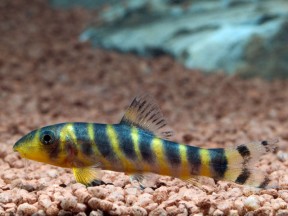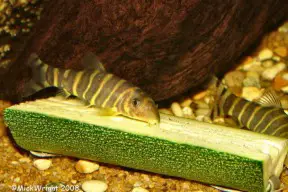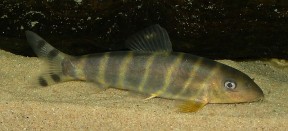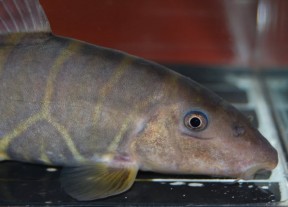Botia dario
Bengal Loach
SynonymsTop ↑
Cobitis dario Hamilton, 1822; Cobitis geto Hamilton, 1822; Botia geto (Hamilton, 1822); Canthophrys (Diacantha) zebra Swainson, 1839; Canthophrys (Diacantha) flavicauda Swainson, 1839; Botia macrolineata Teugels, De Vos & Snoeks, 1986
Classification
Order: Cypriniformes Family: Botiidae
Distribution
Found throughout much of the middle to lower Ganges and Brahmaputra river drainages in northern India, Bangladesh and Bhutan.
In India it’s been recorded in the states of Uttar Pradesh, Bihar, West Bengal, Meghalaya, Assam and Arunachal Pradesh, in southern Bhutan from the Gaylegphug River and in Bangladesh from the Divisions of Dhaka (Mymensingh district), Sylhet, Rajshahi and Rangpur in the north plus the Hill Tracts of Chittagong Division in the south of the country.
Habitat
Little information is available but presumably a riverine species and considering parts of its range are among the wettest in the world likely to be migratory to some extent.
It appears on a checklist of some Brahmaputra tributaries, including the Barak River, published in 2007 alongside numerous species including Barilius bakeri, B. barna, B. dogarsinghi, Laubuca laubuca, Devario aequipinnatus, D. dangila, D. devario, Pethia conchonius, P. ticto, Crossocheilus latius, Garra annandalei, G. nasuta, Psilorhynchus balitora, Balitora brucei, Acanthocobitis botia, Schistura vinciguerrae, Botia rostrata, Pangio pangia, Canthophrys gongota, Lepidocephalichthys annandalei, L. guntea, Batasio batasio, Mystus bleekeri, Gagata gagata, Erethistes pusillus, Chaca chaca, several Glyptothorax spp. and Parambassis ranga.
Maximum Standard Length
120 – 130 mm.
Aquarium SizeTop ↑
Base dimensions of 120 ∗ 45 cm or equivalent should be the minimum considered.
Maintenance
All botiids need a well-structured set-up although the actual choice of décor is more-or-less down to personal taste.
A natural-style arrangement could include a substrate of sand or fine gravel with lots of smooth, water-worn rocks and pebbles plus driftwood roots and branches.
Lighting can be relatively subdued and plants able to grow in such conditions like Microsorum pteropus (Java fern), Taxiphyllum barbieri (‘Java’ moss) or Anubias spp. can be added if you wish. These have an added benefit as they can be attached to pieces of décor in such a way as to provide useful shade.
Otherwise be sure to provide plenty of cover as botiids are inquisitive and seems to enjoy exploring their surroundings. Rocks, wood, flower pots and aquarium ornaments can be used in whichever combination to achieve the desired effect.
Bear in mind that they like to squeeze themselves into small gaps and crevices so items with sharp edges should be omitted, and any gaps or holes small enough for a fish to become trapped should be filled in with aquarium-grade silicone sealant. A tightly-fitting cover is also essential as these loaches do jump at times.
Although botiids don’t require turbulent conditions they do best when the water is well-oxygenated with a degree of flow, are intolerant to accumulation of organic wastes and requires spotless water in order to thrive.
For these reasons they should never be introduced to biologically immature set-ups and adapt most readily to stable, mature aquaria. In terms of maintenance weekly water changes of 30-50% tank volume should be considered routine.
Water Conditions
Temperature:23 – 26 °C
pH: 6.0 – 7.5
Hardness: 18 – 179 ppm
Diet
While Botia spp. appear to be chiefly carnivorous they will also eat vegetative matter if available, often including soft-leaved aquatic plants. The natural diet comprises aquatic molluscs, insects, worms, and other invertebrates.
They’re largely unfussy feeders but must be offered a varied diet comprising quality dried products, live or frozen bloodworm, Tubifex, Artemia, etc., plus fresh fruit and vegetables such as cucumber, melon, blanched spinach, or courgette.
Home-made foods using a mixture of natural ingredients and bound with gelatin are also highly recommended.
Chopped earthworm can also provide a useful source of protein but should be used sparingly, and while most botiids also prey on aquatic snails though should never be considered the answer to an infestation since they’re not obligate molluscivores.
Once settled into an aquarium they’re bold feeders and often rise into midwater at meal times.
Behaviour and CompatibilityTop ↑
Not especially aggressive but don’t keep it with much smaller fishes as they may be intimidated by its size and sometimes very active behaviour.
Slow-moving, long-finned species such as ornamental bettas, guppies and many cichlids should also be avoided as trailing fins can be nipped.
More suitable tankmates include peaceful, open water-dwelling cyprinids, while in larger tanks members of Barilius, Luciosoma, Balantiocheilos and Barbonymus become options.
In terms of other bottom-dwellers they will do well alongside most other Botia and in very large tanks, Chromobotia macracanthus. Some cobitid and nemacheilid loaches are also possibilities as are members of Epalzeorhynchos, Crossocheilus and Garra and many catfishes.
As always, thorough research prior to selecting a community of fishes is the best way to avoid problems.
Botia spp. are gregarious, form complex social hierarchies and should be maintained in groups of at least 5 or 6 specimens, preferably 10 or more.
When kept singly they can become withdrawn or aggressive towards similarly-shaped fishes, and if only a pair or trio are purchased the dominant individual may stress the other(s) to the extent that they stop feeding.
That said they seemingly require regular contact with conspecifics, a fact exemplied by a number of behavioural rituals which have been recorded consistently in aquaria (see ‘Notes’).
Sexual Dimorphism
Sexually mature females are normally fuller-bodied than males.
Reproduction
Not known to have been bred in the hobby as with the majority of botiid loaches though some, including B. dario, are being produced on a commercial basis via the use of hormones.
Unfortunately this practice has been taken to a different level in recent years with a number of hybrids appearing on the market, even including an apparent cross between a form of B. histrionica and Chromobotia macracanthus.
NotesTop ↑
Following Grant (2007) this species is included in the B. dario complex of closely-related species within the genus alongside B. striata.
Members are characterised by colour pattern consisting of a base yellow to golden colour with 7-9 blue, green, grey or black body bars usually with thinner, lighter bars between.
In some individuals the bars break up to varying degrees in a process sometimes referred to as anastomosis meaning patterning can be highly variable, and in B. dario base body colour also ranges from light to dusky, yellowish to greenish. It’s among the most easily-recognisable in the genus due to its particularly curved head shape.
There has been considerable doubt cast over the identity of Botia geto, described as a Cobitis alongside B. dario in the same publication by Hamilton (1822). Various authors have since listed it as either valid or a synonym of B. dario and the type specimens were not preserved but it appears certain that C. geto was actually a young specimen of B. dario.
Grant (2007) provided some detailed remarks on the subject while noting that the name B. geto would be available if phylogenetic studies were to find that geographically-separated populations of B. dario represent distinct species.
A further source of confusion is Botia macrolineata Teugels, De Vos & Snoeks, 1986 which is still often listed as valid. Ng (2007) and Grant (2007) both compared this species with specimens of B. dario from the Ganges and Brahmaputra and found them to represent the same species.
Although B. macrolineata was described from close to Bombay (now Mumbai), Maharashtra state, far away from the natural range of B. dario, it’s clear that a mistake was made since the type specimens used were imported by an aquarium fish company, had been in captivity for two years before being preserved and many of the B. dario in the trade are shipped via Bombay (Grant, 2007).
The currently-recognised distribution of the genus Botia extends eastwards from the Indus River basin in Pakistan across northern India, then southwards through Myanmar as far as the Salween drainage (Ataran River). This range was previously much larger but modern studies have resulted in various changes to the taxonomy of both family and genus.
The latter is currently defined by the following combination of characters, as given by Kottelat (2004): mental lobe developed in a barbel; fronto-parietal fontanelle narrow; anterior chamber of gas bladder almost entirely covered by bony capsule, posterior chamber large or rather reduced; anterior process of premaxilla entire, not surrounding a cavity; rostral process rather long, with a more or less distinct ridge along inner edge; top of supraethmoid narrow or broad; optic foramen very small; suborbital spine not strongly curved backwards and bifid; head naked.
The family Botiidae has been widely considered a genetically distinct grouping since Nalbant (2002), having previously been considered a subfamily (Botiinae) of the family Cobitidae. Nalbant also moved some previous members of Botia into the new genus Yasuhikotakia based on a number of morphological characters.
Later Kottelat (2004) made further modifications to the taxonomy, raising Chromobotia for B. macracanthus and confirming that species previously included in the genus Hymenophysa should instead be referred to Syncrossus.
The former alteration was based on colour pattern plus some morphological characters and the latter because Hymenophysa not only represents a spelling mistake (McClelland’s original spelling was Hymenphysa) but is a junior synonym of Botia.
More recently Kottelat (2012) erected the genus Ambastaia to accommodate A.nigrolineata and A. sidthimunki, two former members of both Botia and Yasuhikotakia.
As a result of these works the family Botiidae is thus divided into two tribes within which Botia appears to be the most basal lineage:
Tribe Leptobotiini – Leptobotia, Parabotia, Sinibotia.
Tribe Botiini – Ambastaia, Botia, Chromobotia, Syncrossus, Yasuhikotakia.
Phylogenetic studies by Tang et al. (2005) and Šlechtová et al. (2006) have largely confirmed this system to be correct although the latter disagreed with the placement of Sinibotia, finding it to be more closely related to the tribe Botiini.
Ambastaia nigrolineata and A. sidthimunki were found to be more closely-related to both Sinibotia and Syncrossus than Yasuhikotakia, despite being considered members of the latter at the time. Šlechtová et al. also proposed the use of subfamily names under the following system:
Subfamily Leptobotiinae – Leptobotia, Parabotia.
Subfamily Botiinae – Botia, Chromobotia, Sinibotia, Syncrossus, Yasuhikotakia.
Within these Botia appears to be the basal, i.e., most ancient, lineage and in a more-detailed phylogenetic analysis Šlechtová et al. (2007) confirmed the validity of the family Botiidae with the genera listed above as members rather then being grouped into subfamilies. This more recent, simpler system is the one we currently follow here on SF.
Some behavioural routines exhibited by Botia spp. have been recorded often enough that they’ve been assigned non-scientific terms for ease of reference.
For example during dominance battles (these occur most frequently when the fish have been introduced to a new tank, or new individuals added to an existing group) the protagonists normally lose much of their body patterning and colouration, a phenomenon that’s come to be known as ‘greying out’.
Such displays will sometimes also happen within an established group as individuals seek to improve social ranking but are usually nothing to worry about.
Interestingly some observations suggest that the character of the highest-ranked, or alpha, fish appears to affect that of the whole group though it must be said that scientific studies of botiid loach behaviour are virtually non-existent.
It certainly seems that they display a degree of ‘personality’ with some specimens being naturally bolder or more aggressive than others, for example. The alpha is normally the largest specimen within the group and often female.
‘Shadowing’ is an interesting behaviour in which younger individuals swim flank-to-flank with older, mimicking their every movement. Some keepers report that more than one smaller fish may shadow a larger simultaneously, with even three or four on each side!
The reason for it is unknown; it may relate to a group staying in touch with one another when rivers swell during times of flooding, perhaps reducing drag by swimming ‘in formation’ or having some other communicative function.
It’s been observed in aquaria with both high and low water flow and seems to be habitual to the extent whereby some individuals will shadow other fishes if no conspecifics are present.
Sound also appears to be an important factor in communication since these loaches are able to produce audible clicking sounds, these increasing in volume when the fish are excited. The behavioural aspects of this phenomenon remain largely unstudied but the sounds are thought to be produced by grinding of the pharyngeal (throat) teeth or subocular spines.
A further curiosity is the so-called ‘loachy dance’ which involves an entire group swimming in a constant, restless fashion around the sides of the tank, usually utilising the full length and height.
The reasons for this are unknown and reports as to when it occurs vary but the most common triggers appear to be the addition of food, fresh water or new conspecifics, and it can last anything from a few minutes to a day or more.
Botiids also often settle at peculiar angles, wedged vertically or sideways between items of décor, or even lying flat on the substrate. This is no cause for alarm and appears to be a natural resting behaviour.
Botia spp. also possess sharp, motile, sub-ocular spines which are normally concealed within a pouch of skin but erected when an individual is stressed, e.g., if removed from the water. Care is therefore necessary as these can become entangled in aquarium nets and those of larger specimens can break human skin.
Botiids are also susceptible to a condition commonly referred to as ‘skinny disease’ and characterised by a loss of weight. This is especially common in newly-imported specimens and is thought to be caused by a species of the flagellate genus Spironucleus.
It’s treatable although the recommended medication varies depending on country. Hobbyists in the UK tend to use the antibiotic Levamisole and those in the United States Fenbendazole (aka Panacur).
References
- Hamilton, F., 1822 - Edinburgh & London: 1-405
An account of the fishes found in the river Ganges and its branches. - Grant, S., 2007 - Ichthyofile Number 2: 1-106
Fishes of the genus Botia Gray, 1831, in the Indian region (Teleostei: Botiidae). - Kar, D. and N. Sen, 2007 - Zoo's Print Journal 22(3): 2599-2607
Systematic List and Distribution of Fishes in Mizoram, Tripura and Barak Drainage of Northeastern India. - Kottelat, M., 2004 - Zootaxa 401: 1-18
Botia kubotai, a new species of loach (Teleostei: Cobitidae) from the Ataran River basin (Myanmar), with comments on botiinae nomenclature and diagnosis of a new genus. - Kottelat, M., 2012 - Raffles Bulletin of Zoology Supplement 26: 1-199
Conspectus cobitidum: an inventory of the loaches of the world (Teleostei: Cypriniformes: Cobitoidei). - Nalbant, T. T., 2002 - Travaux du Museum d'Histoire Naturelle 'Grigore Antipa' 44: 309-333
Sixty million years of evolution. Part one: family Botiidae (Pisces: Ostariophysi: Cobitoidea). - Nalbant, T. T., 2004 - Travaux du Museum d'Histoire Naturelle 'Grigore Antipa' 47: 269-277
Hymenphysa, Hymenophysa, Syncrossus, Chromobotia and other problems in the systematics of Botiidae. A reply to Maurice Kottelat. - Ng, H. H., 2007 - Zootaxa 1608: 41-49
Botia udomritthiruji, a new species of botiid loach from southern Myanmar (Teleostei: Botiidae). - Tang, Q., B. Xiong, X. Yang and H. Liu, 2005 - Hydrobiologia 544(1): 249-258
Phylogeny of the East Asian botiine loaches (Cypriniformes, Botiidae) inferred from mitochondrial cytochrome b gene sequences. - Tang, Q., H. Liu, R. Mayden and B. Xiong, 2006 - Molecular Phylogenetics and Evolution 39(2): 347-357
Comparison of evolutionary rates in the mitochondrial DNA cytochrome b gene and control region and their implications for phylogeny of the Cobitoidea (Teleostei: Cypriniformes). - Šlechtová, V., J. Bohlen and H. H. Tan, 2007 - Molecular Phylogenetics and Evolution 44(3): 1358-1365
Families of Cobitoidea (Teleostei; Cypriniformes) as revealed from nuclear genetic data and the position of the mysterious genera Barbucca, Psilorhynchus, Serpenticobitis and Vaillantella. - Šlechtová, V., J. Bohlen, J. Freyhof and P. Ráb, 2006 - Molecular Phylogenetics and Evolution 39(2): 529-541
Molecular phylogeny of the Southeast Asian freshwater fish family Botiidae (Teleostei: Cobitoidea) and the origin of polyploidy in their evolution.











